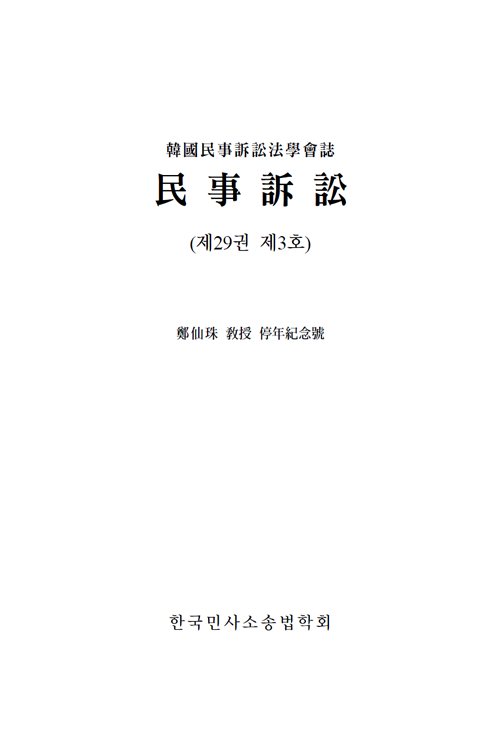- 영문명
- Litigation Relationship Among Multiple Subrogating Creditors in a Creditor's Subrogation Action
- 발행기관
- 한국민사소송법학회
- 저자명
- 정우채
- 간행물 정보
- 『민사소송』제29권 제3호, 293~328쪽, 전체 36쪽
- 주제분류
- 법학 > 법학
- 파일형태
- 발행일자
- 2025.10.30

국문 초록
This paper critically examines the legal principles of Supreme Court Decision 2013다30301 concerning the intervention of other creditors as co-litigants in a pending creditor's subrogation lawsuit, seeking to propose a more rational and stable alternative interpretation. The analysis confirms that while the current Supreme Court precedent is positively regarded for being the first to recognize the procedural right of other creditors to participate, it reveals two significant limitations in its specific requirements.
First, by linking the “necessity of a uniform outcome” the basis for allowing co-litigation intervention to the coincidental and uncertain fact of the debtor's subjective awareness, it places the important procedural rights of other creditors in an unstable position and seriously undermines the predictability of the legal relationships in the litigation. Second, the standard that deems the subrogating creditor's claim as an explicit partial claim (despite their intention to claim the subrogated right only within the scope of their own preserved claim) and stipulates that an intervener's claim amount cannot exceed the original plaintiff's, leads to an irrational result that hinders the single, conclusive resolution of disputes and harms judicial economy.
With these issues in mind, this paper presents two new perspectives as interpretive alternatives under the current law. The first is that the standard for permitting co-litigation intervention should be based on the “substantive identity of the subrogated claim.” The second is that the “necessity of a uniform outcome” should not be limited to the issue of the extension of res judicata but should be interpreted more broadly to include substantive law requirements, the prevention of contradictory judgments, and judicial economy.
If the new interpretive theories proposed in this paper are adopted, creditor's subrogation lawsuits involving multiple creditors could be managed more stably and efficiently. As long as the subrogated claim is identical, other creditors could intervene in the lawsuit to assert their rights without being limited by the amount of their own preserved claims. This would allow the court to examine all related interests within a single proceeding and deliver a consistent, unified judgment. Such an approach would not only robustly protect the procedural rights and interests of the parties but also significantly contribute to preventing the waste of judicial resources from duplicative lawsuits and expediting the final resolution of disputes.
Despite efforts to improve the system through interpretation, changing precedents takes time, and confusion in lower courts may persist. Therefore, a legislative solution is ultimately desirable to fundamentally resolve the procedural issues of subrogation lawsuits contested by multiple creditors and to secure legal stability.
It is necessary to actively consider creating an express provision in the Civil Procedure Act that accounts for the unique nature of creditor's subrogation lawsuits, similar to Article 249, Paragraph 2 of the Civil Execution Act, which explicitly allows for the co-litigation intervention of other creditors in a collection lawsuit. For instance, a provision could be introduced stating, “Where a creditor's subrogation lawsuit is pending, another creditor seeking to exercise a subrogation right with respect to the same subrogated claim may intervene in the lawsuit as a co-litigant.” Furthermore, imposing a duty on the original plaintiff to notify other creditors of the pending lawsuit, or allowing the court to provide participation opportunities to other interested creditors on its own motion, could be considered. Supplementing the law in this manner to eliminate the shortcomings of the current system and to complete a clear and stable procedural guarantee is the direction our civil procedure law should take in the future.
영문 초록
목차
Ⅰ. 문제의 제기
Ⅱ. 채권자대위소송의 법적 성격과 소송구조
Ⅲ. 현행 판례 법리의 한계와 문제점
Ⅳ. 비교법적 검토: 일본의 채권자 대위소송 기판력 법리
Ⅴ. 새로운 해석론의 모색: 공동소송 참가 요건의 재구성
Ⅵ. 결론
참고문헌
키워드
해당간행물 수록 논문
참고문헌
최근 이용한 논문
교보eBook 첫 방문을 환영 합니다!

신규가입 혜택 지급이 완료 되었습니다.
바로 사용 가능한 교보e캐시 1,000원 (유효기간 7일)
지금 바로 교보eBook의 다양한 콘텐츠를 이용해 보세요!


